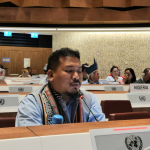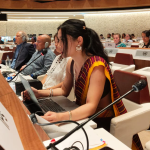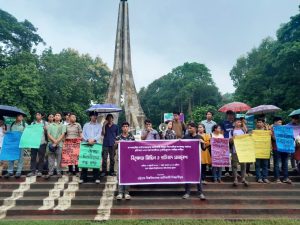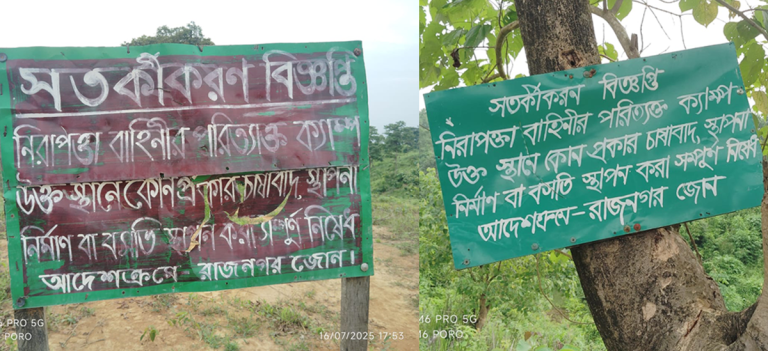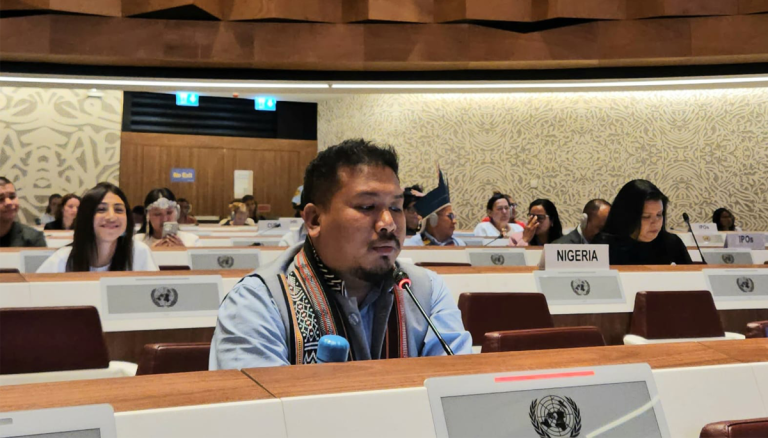Tanisha Chakma
It is time indigenous culture stops being stolen from
On July 21, a photo album was uploaded on Bibi Russell’s Facebook page, offering a glimpse of the acclaimed designer’s new collection. The very first image from this collection was that of a blue scarf bearing the distinct patterns of a Chakma hadi.
Over this traditional garment, a hand was shown holding the designer’s business card — “Bibi Russell/Artiste de l’UNESCO pour la paix” (Russell was made a UNESCO artist for peace in 2001).
When a few people pointed out that the hadi — the design of which has been a cultural knowledge of the Chakma people for generations — should not be claimed as Russell’s own creation, she and her social media team began to censor comments. At least one user was blocked after she criticized Russell’s conduct on her own page.
A majority of those whose voices were suppressed by Russell and her team belonged to the Chakma community. By July 23, the image of the hadi had been removed, with no public acknowledgement.
Not just appreciative borrowing
The indiscreet use of indigenous cultural property for personal profit and a reluctance to be held accountable by that same indigenous community for failing to give due credit are characteristics of a specific form of colonial exploitation known as cultural appropriation.
With global designers often freely borrowing ideas and inspirations from cultures that are not their own, appropriation of both indigenous and non-indigenous cultures is rampant in the fashion industry worldwide. Appropriation, however, is not merely the appreciative borrowing of elements from another culture.
The latter is not an inherently harmful practice; in fact, not only is cultural exchange inevitable in today’s hyper-connected, globalized world, it also reflects our historical reality in the melting pot of the Indian subcontinent. Learning about and appreciating cultural differences enriches our understanding of humanity and is crucial for establishing a harmonious society.
So what makes cultural appropriation exploitative, and different from borrowing or appreciating another culture?
Borrowing — as the word implies — assumes consent of the owner. In the case of intangible cultural designs or sartorial practices of which ownership is not invested in any one person, consent is nuanced and has to be negotiated through mutual respect, goodwill, and acknowledgement. Cultural appropriation, then, is the borrowing of cultural elements in bad faith where proper acknowledgement and respect is lacking.
In simpler words, cultural appropriation is more akin to theft than borrowing. It is not an exchange made on equal terms; the mechanism of exploitation in cultural appropriation operates on the back of an imbalance of power between the parties involved.
The dominant culture always stands to benefit more at the expense of a vulnerable group. For example, in the relationship between a nationally celebrated, UNESCO-certified, London-educated Bengali designer and the Chakma people — an already marginalized ethnic, linguistic, and religious minority in Bangladesh — the balance of power tips overwhelmingly in the designer’s favour.
This enables her to unfairly receive the lion’s share of recognition and profit for an already existing cultural design. On the other hand, the origin and identity of the garment, along with the intellectual and physical labour of its Chakma weaver, are rendered invisible.
More than a fashion statement
Some might question the validity of my concerns; after all, am I not making a mountain out of a molehill over the minor issue of clothing? Clothing, however, has never been merely clothing. Dress has always been a powerful expression of cultural identity that has been used simultaneously to distinguish and discriminate.
In the court of Mughal emperor Akbar, even though all courtiers wore the same uniform, Hindus fastened the ties of their jama to the left, while Muslims fastened theirs to the right. The freedom to wear whatever one wants is a relatively new phenomenon and even then, a privilege restricted generally for the elite.
Until as recently as 1859, sumptuary laws proscribed the wearing of upper garments to Nadar women from present-day Kerala, who had to pay a heavy tax if they wished to cover their breasts in public. While the wearing of clothing such as the saree or salwar kameez is not limited to any one South Asian community, other items of clothing are reserved for specific groups due to their deep significance.
Consider the hijab: On the surface, it is simply a rectangular piece of fabric. However, it is not worn for aesthetic reasons; it is a garment worn due to religious injunction and it identifies the wearer’s faith. Women wearing the hijab may face discrimination for their choice of clothing where Islam is not ingrained in the dominant culture — take, for example, the 2004 French law which prohibits the wearing of religious symbols in public schools.
We understand, then, that it would be ignorant and offensive for a non-Muslim woman to wear a hijab as a fashion statement, to put on and cast aside at will, because that would trivialize the commitment and devotion of the Muslim women who don the garment every day.
This disregard for the cultural significance of a piece of clothing is a telltale trait of cultural appropriation, which seeks to remove its object from its specific cultural context and strip it of its specific meaning. Indigenous cultures are particularly vulnerable to this practice due to their marginalization.
In Canada, indigenous children put in government-run residential schools were required to wear Western-style clothing, or face severe punishments. It would therefore be insensitive and exploitative for Canadian companies to produce the very same garments that were forbidden to indigenous children, and market them as fun fashion accessories to consumers who do not understand their cultural significance. It would trivialize the traumatic loss of culture suffered by these children as a result of the government’s forced assimilation policies.
Keeping with the times
For an example of this kind of cultural appropriation in an American context, see Karlie Kloss’s controversial 2012 runway look for Victoria’s Secret, where she paired her lingerie with a Native American headdress. Karlie Kloss and Victoria’s Secret apologized for the offense caused, and since then, global attitudes have been changing.
After accusations of misrepresentation and cultural appropriation in Disney’s 2013 animated film Frozen, the studio collaborated with the Sámi people of Norway on its 2019 sequel Frozen 2. Earlier this year, Sealaska Heritage Institute sued Neiman Marcus for copying an Alaskan Native design.
In keeping with the times, Bangladeshi designers and consumers also have a moral obligation to develop a better understanding of the harmful effects of cultural appropriation. Like all cultural garments described above, the Chakma pinon and hadi are not worn for aesthetic reasons only. The patterns used in the weaving of these pieces are carefully laid out according to another piece of fabric known as the alaam, which contains a collection of permissible designs and which serves as a reference to weavers.
Each indigenous community in Bangladesh uses a distinct set of designs in weaving their garments. Specific designs are thus associated with specific indigenous groups. Just like how the colour and pattern of a tartan fabric can identify a Scottish clan, the pinon and hadi identify the wearer as belonging to the Chakma community. To include a hadi among a fashion collection of generic fabrics with no allusions to its origin or history, then, is to erase that identity.
Various other examples exist of the continuous erasure of indigenous identity in Bangladesh. To celebrate the International Day of the World’s Indigenous Peoples in 2016, the Daily Star featured only Bengali models in a piece showcasing indigenous attire.
In 2018, Rtv aired a special drama called Oshomoy on International Mother Language Day, where — ironically — Bengali actress Mehazabien Chowdhury, who does not speak the Chakma language, played the lead role of a Chakma woman. Filmmaker Maksud Hossain’s 2019 short titled Remakri was set and shot in Bandarban, but did not include a single indigenous person in its cast or crew.
While the intentions behind these projects were well-meaning (if rather misguided), there are more sinister examples: In Sajek Valley, tourists can now play dress-up in the garb of the same indigenous peoples who were forcefully displaced in order to create the tourist spot.
Acknowledge, educate, respect
As an indigenous person in Bangladesh, our dress is part of our identity and that identity is vulnerable due to the constant implicit pressure to assimilate. Unlike the Bengali jamdani, the pinon, hadi, and other indigenous garments are not registered as geographical indication (GI) products, but designers and consumers can still help protect the cultural property of indigenous peoples by using them responsibly.
If you are a designer and you were inspired by indigenous designs: Please acknowledge the indigenous community and use your platform to educate more people about our crafts. Know and use the proper names for our garments and do not disregard their significance. Giving credit where credit is due does not diminish your artistry, but appropriating culture without consent certainly does.
If you are a consumer interested in wearing indigenous designs: Wear our clothes with intention and respect. Purchase them from indigenous weavers whenever possible, as this supports the artisans directly. Learn to recognize the traditional designs of our indigenous fabrics as easily as you would recognize the patterns of a jamdani saree. Speak up whenever you notice instances of cultural appropriation.
That would be true appreciation of our culture.
Tanisha Chakma is a doctoral student at the Department for the Study of Religion, University of Toronto.
Source: dhakatribune.com




